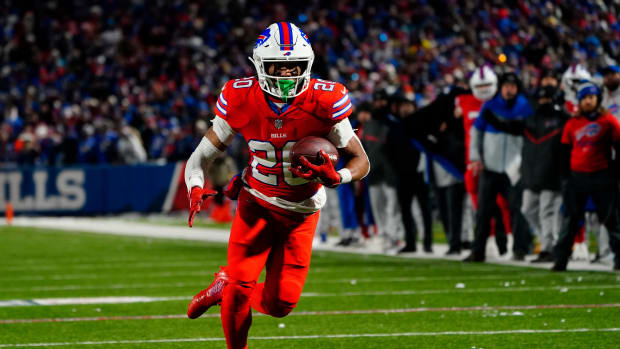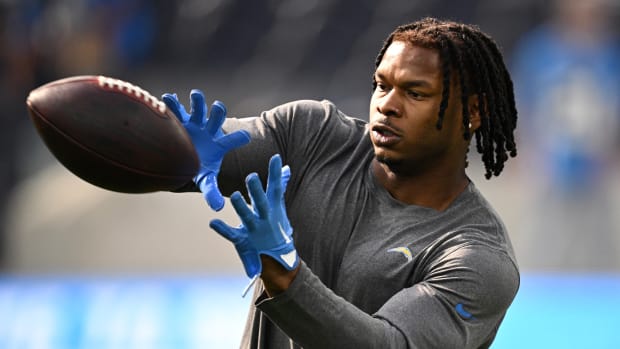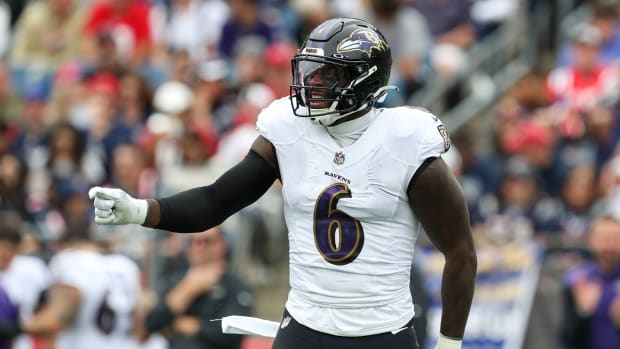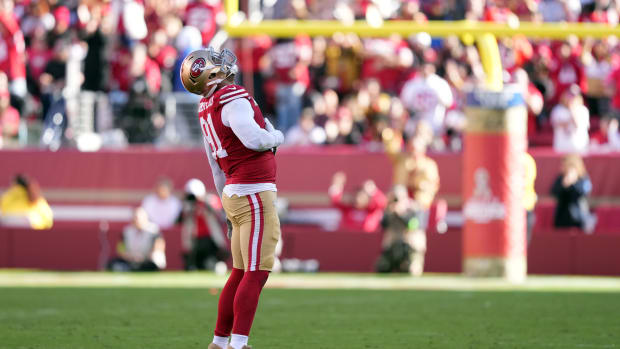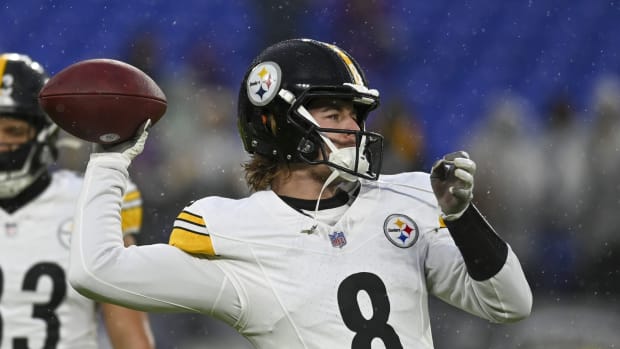
The Evolution of the L.O.B.
(Harry E. Walker/Getty Images)
By Doug Farrar
The most compelling matchup in Super Bowl XLVIII will undeniably be the Broncos’ passing attack against the Seahawks’ secondary. Peyton Manning had his best season in 2013, and outside men Eric Decker and Demaryius Thomas, slot expert Wes Welker, and tight end Julius Thomas comprise perhaps the most talented receiving corps he’s ever thrown to. The Broncos can beat you with numbers, bewilder you with options, and use a surprising number of different formations despite playing a large amount of no-huddle. Factor in Manning’s uncanny ability to read a defense’s intentions—he may be the best in NFL history at doing so—and stopping Denver’s offense is a lot like trying to solve a Rubik’s cube at full-sprint.
The Seahawks will endeavor to do so with a physically gifted defensive backfield that is capable of shutting down any premiere set of receivers in the NFL. Cornerback Richard Sherman is known primarily for his rant after NFC Championship Game, but even a cursory look at game film reveals why he keeps his opponents on lockdown at a league-best rate: he’s so refined in his technique, and he uses comprehensive film study to break down route concepts. Safety Earl Thomas is the rangiest defender since Ed Reed in his prime; strong safety Kam Chancellor is a pure old-school intimidator who has rounded out his game impressively; and new starter Byron Maxwell’s 47.7 quarterback rating allowed nearly matches Sherman’s NFL best 47.3 (per Pro Football Focus’s game charting).
Seattle’s young corners like to press in outside coverage to disrupt the timing of receivers. Throwing fades and sideline routes against them is generally a fool’s errand, because the Seahawks teach their defensive backs to establish inside position on intermediate and deep routes of any stripe, with authority. Manning, however, can and will find holes in any secondary—even in Seattle’s top-ranked passing defense—by dissecting schemes in the pre-snap phase. Show him the same thing too often, even when it’s a disguised look, and you will soon have trouble on your hands.
“That’s one of the things that you have to work through in practice—to make sure what your look is, and that was important for us as we went into the playoffs,” Seahawks defensive coordinator Dan Quinn said on Jan. 23. “What were some of our tells as we went through our own self-scouting? That was one of the advantages of having that time ... going into the postseason where we had a chance to go back and look at some of the things that we do, things that we do well, and what are some of our own alerts.”
Triple Threat
There's one formation Peyton Manning can use to get the Seahawks' secondary right where he wants them. FULL STORY
I asked head coach Pete Carroll on Jan. 24 whether the experience his secondary had together allowed him to open the playbook, because it sure looks like it. Seattle’s secondary had been vulnerable in certain coverages, because the bail-and-follow technique doesn’t really reflect this team’s aggressive mentality. But during the stretch run of the regular season, the Seahawks started using more cornerback/safety switches, more disguised coverages, and more zone concepts beyond their preferred single-high and 2-man schemes.
“Yeah, it’s really been a help because getting prepared for this offense and the quarterback, we have to be able to do everything,” Carroll said of Manning. “We have to be able to pressure him, we have to be able to play zone and man, do all of the things. Hopefully give him some new looks the he can’t prepare for. We have to find a way to get him out of his normal rhythm. Very few teams have been able to do that. So it’s a big challenge and we are using the experience and the background that we have to pull out everything that’s necessary for this game plan.”
The Seahawks and Broncos did meet in 2013, in the second game of each team’s preseason. It was a 40-10 rout by Seattle, which, of course, has no predictive value on who will win the Lombardi Trophy. And yet, three early plays from that game do reveal some interesting things that Manning will likely throw at the Seahawks—and what he may see in return. Before backup Brock Osweiler stepped under center halfway through the second quarter, Manning had completed 11 of 16 passes for 163 yards and a touchdown, and Denver’s offense was complex enough to make reviewing a preseason game a worthwhile endeavor.
Denver went three-and-out on its first drive because Welker gained only eight yards on a 3rd-and-10 crossing route. Chancellor was assigned to stop Welker on that play, and he provided a clampdown that would foreshadow his improvement in coverage this season. The Seahawks now use Chancellor in different spots—everywhere from deep safety, to the slot, to run support, to flat/seam coverage. He’s become another moveable chess piece for a defense that has gained new dimensions. And if Welker wants to try a few of those notorious pick plays ... well, the 6-3, 232-pound Chancellor will be more than happy to play that game.
Julius Thomas led the Broncos with a team-high 12 catches for 123 yards in this preseason tilt, a harbinger of the Pro Bowl-level season he would have after two years of relative anonymity. The way he took linebacker K.J. Wright up the right seam for an 18-yard gain with 3:54 left in the first quarter is a pretty good indicator that the Seahawks will see this concept again.
A full season later, however, Seattle’s linebackers—Wright, Bobby Wagner, and Malcolm Smith—have each improved their coverage abilities. In two matchups against the Seahawks, Saints tight end Jimmy Graham caught just four passes for 50 yards on 15 targets. (In each of the Saints’ other 14 games, Graham averaged six receptions, 83.2 yards and nine targets.) Wright and Smith are especially effective when asked to drop into coverage from the middle of the field to the seams, so when Manning targets Thomas over the middle, he must realize that he’s seeing a higher level of defense than before.
Denver’s top receiver, Demaryius Thomas, struggled at times against Seattle’s aggressive cornerbacks in straight one-on-one matchups. His attempt to get free on a deep crossing pattern with 2:50 left in the first quarter was thwarted by cornerback Brandon Browner, who is no longer with the team. (Browner was suspended indefinitely in December for violating the league’s substance abuse policy). However, Browner used the same techniques that every Seahawk cornerback understands: disrupt, get inside, and go after the football.
One play later, Denver lined up in bunch formation to the right, and Julius Thomas was wide open for a 31-yard gain. Manning hit Welker for Denver’s only touchdown two plays later. Teams will often counter aggressive press coverage with trips and bunch formations because they force defenses to play more reactively. The Colts suckered Seattle with these concepts more than once in their 34-28 win in Week 5. But the Seahawks will now switch corners and safeties, disguise their intentions, and have a better idea of how to handle Denver’s tricky stuff.
“Well, that’s how teams want to attack us now,” Earl Thomas said last week. “They don’t want our big corners to press, and they don’t want us to mess up the timing. So they’re getting in condensed formations, hanger formations, bunch formations, but we know that. We understand how teams want to attack us and that’s the beauty of it. That’s why I love meetings and that’s why I love game-planning, because you’re really getting all you need for the test and when you get out there on Sundays, you’re going to get an ‘A’.”
The Seahawks could wind up with more than an ‘A’ if they have paid close enough attention in the film room. The degree to which their defense is able to keep Manning under wraps will most likely be the deciding factor as Seattle tries to claim its first Lombardi Trophy.









































